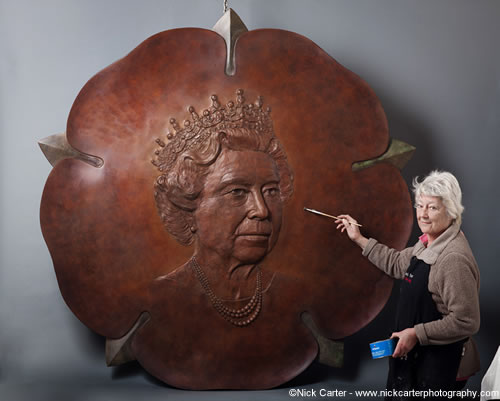Vivien Mallock’s work, principally in bronze, covers a wide spectrum from portraiture and large monuments to small figurative pieces of both human and wildlife subjects.
She has been a member of the Royal Society of British Sculptors since 1998 and is much in demand for bronze portraits.
Her largest work to date, the nine-foot memorial to the Royal Tank Regiment, unveiled by HM The Queen in 2000, stands in Whitehall Court and depicts the five-man crew of a Comet tank. In 2013, her large bronze roundel bass relief portrait of Her Majesty The Queen was unveiled in the Great Hall in Winchester.
She has completed a number of public sculptures of military figures, eight of which constitute a unique series in Normandy, of every level of command from ‘Monty’ (a second casting of which is installed in Portsmouth) to Major John Howard near Pegasus Bridge. She recently completed a memorial bronze bass relief of the Polish commander Major General Stanislaw Sosabowski near Arnhem and in early 2014 her bust of Winston Churchill was unveiled in the Pentagon’s Hall of Fame as a gift from the British Government to the US Department of Defense.
In 2015, the bicentenary of the Battle of Waterloo, her memorial to the British who fell 1815 was unveiled in Hougoumont Farm at the scene of the Battle. Her most recent subjects have varied from footballers Brian Clough and Arthur Wharton to Sir Walter Raleigh. She was the last artist for whom Queen Elizabeth The Queen Mother sat for a portrait. In October 2013, her bronze memorial to the Army Air Corps, a golden eagle, was installed at the National Memorial Arboretum in Staffordshire. This has been joined more recently by regimental memorials to the Devon and Dorset Regiment and the King’s African Rifles.
Her most recent public work was a 7-foot statue to Lord Trenchard at RAF College Cranwell in 2020, the centenary of the College.
Between her commitments to commissions, she also enjoys sculpting smaller works of animals, birds and human subjects, many of which rely for their effect on her ability to suggest activity and character.

